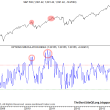by Tom Brakke, Research Puzzle
Published in early 2004, The Paradox of Choice by Barry Schwartz carried the subtitle, “Why More is Less.” That summer, I read it as I prepared to make selection choices among prospective research providers for the Global Research Analyst Settlement.
by Barry Schwartz carried the subtitle, “Why More is Less.” That summer, I read it as I prepared to make selection choices among prospective research providers for the Global Research Analyst Settlement.
Faced with an array of possible approaches — what providers to select and how to use them to meet conflicting goals with a relatively small budget — reading the book helped me to put my choices in context.
As the book’s dust jacket says, “we assume that more choice means better options and greater satisfaction.” On the contrary, it can lead to lots of time, effort, and money being spent unwisely, and greater disappointment with a decision after the fact. Our lives, filled with seemingly unlimited choices and complexity, can devolve into “decision-making paralysis, anxiety, and perpetual stress.”
The most memorable aspect of the book for me was the difference between a “maximizer” and a “satisficer.” In essence, the former aims for the best choice possible in a given situation and the latter for a good-enough one. Which person ends up being happier with their decision? It’s a complex question, but often it’s the satisficer, since the maximizer has a notion of expected utility from the decision that often is not met. The cost of that time, effort, and money spent on the decision doesn’t result in outcomes that are commensurately better.
With that cursory review of one part of the book’s message, let’s think about how it might apply to investment decisions. The easy analogy is that of an active investor versus a passive investor, since the historical record indicates that active asset managers have great difficulty beating a passive index over time. Is the quest worth it? Why not just index and relax?
“Pension funds have a fiduciary duty to hire the best managers,” said a recent posting on the blog Hedge Funds. First off, I don’t think that’s an accurate representation of fiduciary duty. In addition, the inherent assumption is that the “best managers” of the future can be readily identified in advance and combined in ways that will add value over time.
First off, I don’t think that’s an accurate representation of fiduciary duty. In addition, the inherent assumption is that the “best managers” of the future can be readily identified in advance and combined in ways that will add value over time.
There’s not much evidence that’s the case, and the more money you spend on the selection process and the fees for those managers that are deemed to be the “best,” the bigger the hurdle you have to jump. As in other situations, someone intent on being an investment maximizer can easily be allured by perceived utility (almost always based upon historical performance numbers) and end up with an experienced utility that trails that of the satisficer.
In reference to Schwartz’s work and other studies, a situation is often posed that begins like, “Imagine yourself in a cereal aisle.” There are all kinds of choices in front of you. But that selection is nothing compared to the financial product aisle, full of scores of strategies in many different packages (mutual funds, ETFs, separate accounts, etc.), offered by thousands of providers. It is all overwhelming; the dizzying selection often contributes directly to poor decisions and the generalized disappointment that is widespread among investors today.
Should investors always and everywhere be satisficers, using simple allocations and indexation strategies? Not necessarily, but that is a convenient base case with which to compare other alternatives — and not an imprudent choice under most conditions.
But the business of investment management is fueled by maximizers: Clients desperate to find the “best” managers, and investment decision makers eager to produce performance that brands them as such. (The management firms, of course, are busy trying to maximize assets and fees.) The results have been, for the most part, uninspiring — and certainly a letdown in light of all of the effort expended.
Setting those broader concerns aside, the next two postings will examine ideas and strategies for dealing with an investment market that offers overwhelming choices. First up will be some suggestions for the buyers of investment products and services on how to sort through the confusing maze, followed by recommendations for providers trying to differentiate their offerings from competitors in the investment industry.














